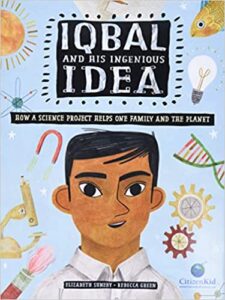This blog post is part of the blog post series I wrote about picture book biographies. Here is the complete list.
To summarize a person’s life in 32 pages with less than 1000 words, we need to select the time frame carefully.
The simplest and the most obvious choice is to start the story with the character’s birth and let the character’s death marks the story’s end. However, for many stories, this time frame is pointless and makes the story a boring info dump.
Some biographies are far better to be portrayed in a single event, rather than covering all life events. Some are better to show only the character’s adulthood. A perfect time frame for one story could be a wrong choice for another story. The best time frame depends on the story and thematic message you want to convey to your reader.
Possible timeframes
Generally speaking, our choices for the time frame are listed below.
- Cradle-to-grave
- Only childhood
- Starting in adulthood, flashback to childhood
- All in adulthood
Most picture book biographies, both the recently published ones and those published a long time ago, cover cradle-to-grave the character. You easily can find plenty of them. Let’s focus on the less obvious time frames with some published picture books.
Only childhood
This time frame suits those characters who achieved a goal in their childhood/teenhood. Thus, it is not applicable to most stories because usually the accomplishments happen in adulthood.
The story of IQBAL AND HIS INGENIOUS IDEA: HOW A SCIENCE PROJECT HELPS ONE FAMILY AND THE PLANET (2018) by Elizabeth Suneby and Rebecca Green starts and ends in Iqbal’s teenhood.

HONEY, THE DOG WHO SAVED ABE LINCOLN (2020) by Shari Swanson and Chuck Groenink tells the story of the friendship between young Abe and his dog. The story ends when Honey saved Abe.

ITZHAK: A BOY WHO LOVED THE VIOLIN (2020) by Tracy Newman and Abigail Halpin starts when Itzhak was three and ends when he went for a play in New York at the age of 13.

DANCING HANDS : HOW TERESA CARREÑO PLAYED THE PIANO FOR PRESIDENT LINCOLN (2019) by Margarita Engle and Rafael López

Starting in adulthood, flashback to childhood
The first two spreads of MISTER ROGERS’ GIFT OF MUSIC (2022) by Donna Cangelosi and Amanda Calatzis are about adult Mr. Roger. The third spread goes back to his childhood and the story continues until he got old.

THE FASTEST GIRL ON EARTH!: MEET KITTY O’NEIL, DAREDEVIL DRIVER! (2021) by Dean Robbins and Elizabeth Baddeley

The first three spreads of THE VAST WONDER OF THE WORLD: BIOLOGIST ERNEST EVERETT JUST (2018) by Mélina Mangal and Luisa Uribe show Ernest’s adulthood. On the fourth spread and after that, we read about his childhood.

All in adulthood
You may have heard this advice that characters in children’s books are better to be children. This advice, like other writing advice, should be taken cautiously. If childhood events are unrelated to the story, there is no reason to start from childhood. I will discuss info dump in picture book biographies in a separate blog post but I briefly mention here that, in most cases, you can find lots of info dump on the first two or three spreads of picture book biographies where the author gives irrelevant information about the character’s childhood.
The story of BERTHA TAKES A DRIVE: HOW THE BENZ AUTOMOBILE CHANGED THE WORLD (2017) by Jan Adkins happens on one day in Bertha’s adulthood life. In the early morning, she wakes up two of her elder boys to drive the strange machine her husband invented. They drove sixty miles on the roads proper for horses and sheep, not for automobiles. Their journey and the obstacles they had to overcome are the content of the story.

The story of MAGIC RAMEN: THE STORY OF MOMOFUKU ANDO (2019) by Andrea Wang and Kana Urbanowicz starts with the adult character. This book is about the invention of ramen and how it helped hungry people. Information about Momofuku’s birth, the schools he went to, etc are totally irrelevant to this story.

Here are more examples of picture book biographies that start and end in the character’s adulthood.
SECRETS OF THE SEA: THE STORY OF JEANNE POWER, REVOLUTIONARY MARINE SCIENTIST (2021) by Evan Griffith and Joanie Stone

HOW SCIENCE SAVED THE EIFFEL TOWER (2022) by Emma Bland Smith and Lia Visirin

CLASSIFIED: THE SECRET CAREER OF MARY GOLDA ROSS, CHEROKEE AEROSPACE ENGINEER (2021) by Traci Sorell and Natasha Donovan

OPENING THE ROAD: VICTOR HUGO GREEN AND HIS GREEN BOOK (2021) by Keila V. Dawson and Alleanna Harris 
CEZANNE’S PARROT (2020) by Amy Guglielmo and Brett Helquist

CUBS IN THE TUB: THE TRUE STORY OF THE BRONX ZOO’S FIRST WOMAN ZOOKEEPER (2020) by Candace Fleming and Julie Downing

MARVELOUS CORNELIUS: HURRICANE KATRINA AND THE SPIRIT OF NEW ORLEANS (2015) by Phil Bildner and John Parra 
My picture book biography blog post series includes:
- Introduction to picture book biographies link
- Narrative Structure link
- Selecting timeframe (this blog post)
- Point Of View (POV) link
- Info dump link
I write blog posts about the craft of writing picture books regularly. The list of the previous posts is on the PictureBookPedia. Also, I publish a quarterly newsletter that includes links to my recent blog posts. My next newsletter will be on 01.10.2022.


This is such a great post! Thank you.
Happy that you found it useful.